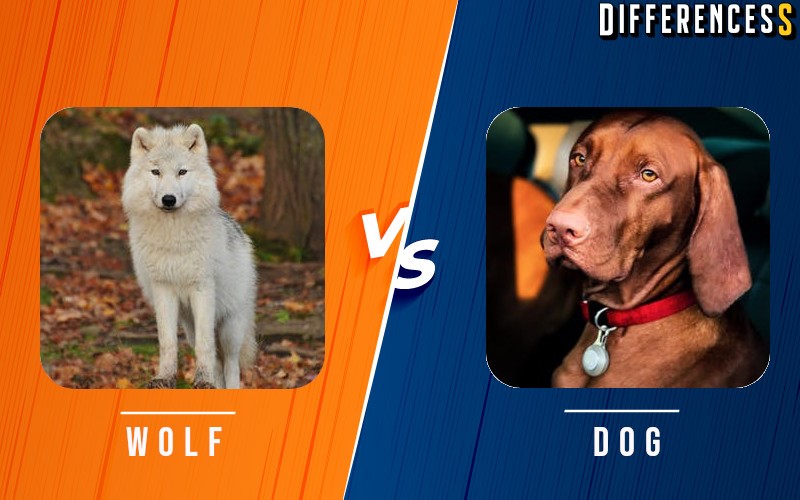
Post Contents
Overview: Dog vs Wolf
Some people may get surprised to know that dogs and wolves share the same ancestral species of an extinct wolf. Both dogs and wolves belongs to the Canidae family and share 98.8% of the DNA. They look alike but have different proclivity, temperament, attacking skills, etc. Dogs are known as “best friends of Humans” hence they can be found at any place where humans live. In wild encounters of wolf and dog is extremely rare but what will happen if they come face to face, who would win if an animal duel occurs between them?? To determine our winner we have to look into their traits, let’s know about them in detail.
Physical Traits:
Dogs are mostly smaller than wolves; skull of dogs, teeth, brain, legs are relatively small while they have different muzzle size. However, some breeds of dog are quite similar in size as that of the wolf. Dogs have cusped teeth, their paw is half of the size as that of a wolf and they may have upward curled tails. Wolves are bigger and stronger than dogs; they have a large, broad skull, long muzzle, large brain, teeth, and leg size.
Behavior:
As dogs are domesticated they are friendly to humans; they can be trained and can perform a particular task. Dogs are social not just to humans but with other pets too; they develop a bond with other animals and play with them. Wolves are also social as they live in packs. They are more intelligent and keeps themselves aware of its ambiance and environment than dogs. As wolves are wild they are hard to tame and it is nearly impossible to train a wolf. Dogs can recognize the facial expression of humans whereas wolves understand the hand movements.
Diet:
Dogs are omnivores, they eat fruits, vegetables, meat, eggs, fish, etc. Wolves are carnivores and feed on meat, fish and hunt other mammals in packs.
Reproduction:
After copulation female dogs give birth after a gestation period of 58-68 days. Dogs reach sexual maturity around 6-12 months. Wolves get sexually mature age 2-3 years of age; they give birth after 62-75 days of gestation period. Breeding in wolves depends on hierarchy, only the alpha female can mate and give birth to the pups.
Battle: Animal Duel: Who Would Win??
Wolves are thought to be dogs’ ancestors. Wolves are quite bigger than dogs; however, some dog breeds like Kangal are equal in size to wolf. Kangal can be a challenging opponent for the wolf; also kangal are known to hunt down the wolves. Nevertheless, wolf would not be easy to beat for kangal; as it is intelligent, muscular, and move in pack. It is almost impossible for other dog breeds to win against the wolf in one on one faceoff.
Kangal may give a fierce battle but wolf is wild and it hunt, so it has more stamina and muscles than kangal. Hence, we’ll like to cast our vote to the wolf’s side and predict it as the winner.
Amazing Fun Facts for kids
- Dogs sense of smell is 40x better than humans.
- Dog Noses can sniff out medical problems and certain chemicals.
- Dogs can sniff and breathe at the same time.
- Some dogs like Newfoundlands are great swimmers and lifeguards.
- Some dogs like Akita could even beat a cheetah.
- Dogs don’t sweat like we do.
Comparison Table: Dog Vs Wolf
| Comparison Head | Dog | Wolf |
|---|---|---|
| Kingdom | Animalia | Animalia |
| Phylum | Chordata | Chordata |
| Class | Mammalia | Mammalia |
| Order | Carnivora | Carnivora |
| Family | Canidae | Canidae |
| Genus | Canis | Canis |
| Species | C. Lupus | C. Lupus |
| Mainly found in | Dogs can be found at any place where humans live. | North America, North Africa, Europe, and Asia. |
| Habitat | Lives in human settlements | They live in woodlands, grasslands, forests, and deserts. |
| Nature | Social, playful; friendly to humans. | Social to other wolves of the pack but shy and avoid encounters with humans |
| Average Body Length | Highly varies depending on breed. | 41-63 inches |
| Average Weight | 30-40 kg | 30-80 kg (males), 23-55 kg (female). |
| Average height | 22-28 inches. Irish wolfhound has a height of about 30 inches | 31-33 inches |
| Shape of Teeth | Small canines | Longer and Thicker canine |
| Paws | Smaller; half the size of a wolf | Large |
| Lifespan | 10-13 years | 6-8 years; reach 13 years rarely in wild but in captivity can live up to 17 years. |